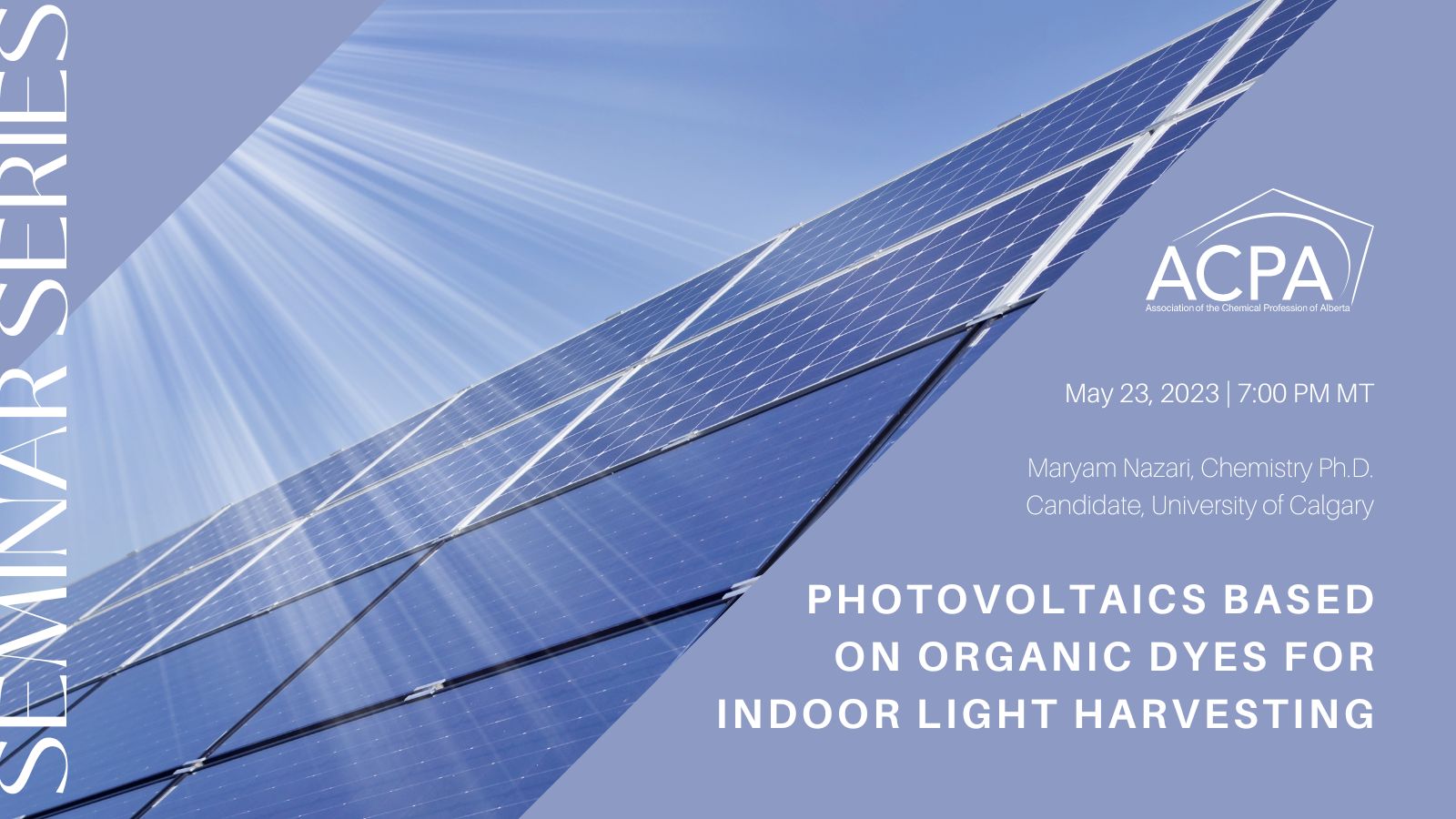ACPA Seminar Series: Photovoltaics based on Organic Dyes for Indoor Light Harvesting
| Starts | 2023-05-23 18:45 |
|---|---|
| Ends | 2023-05-23 20:00 |
| Location | Virtual Event |

Welcome to the ACPA Seminar Series, a monthly webinar series including various topics of interest related to advancing the Chemical Profession in Alberta. For the next seminar in this series, we are happy to introduce Maryam Nazari, Chemistry Ph.D. Candidate at the University of Calgary to speak on 'Photovoltaics based on Organic Dyes for Indoor Light Harvesting' on May 23, 2023. Each seminar will be eligible for 1 PDC credit.
Agenda
6:45 - 6:59 PM MT - Networking
7:00 - 8:00 PM MT - Presentation and Q&A
Seminar Overview
The Internet of Things is a network that connects electronic devices like wireless sensors, radio-frequency identification tags, and Bluetooth beacons to the Internet, allowing them to communicate with each other and monitor their surroundings. While these devices currently rely on batteries for power, the widespread use of batteries can be expensive due to the need for periodic replacements and maintenance, in addition to being harmful to the environment.1 Fortunately, advances in circuit design and device optimization have enabled the use of photovoltaic energy conversion to power Internet of Things devices. Photovoltaic devices based on organic materials are well-suited for the application of harvesting indoor light and converting it into electricity that can power microelectronics. One of the reasons for this is that organic materials have high absorption coefficients, which allow them to effectively capture light. Additionally, the absorption tunability of organic materials allows them to match the emission of indoor light sources, enabling greater efficiency. Organic materials are also highly flexible, which makes them well-suited for niche applications such as wearable electronics. Furthermore, their color tunability allows for customization to fit the aesthetic requirements of the application. Finally, organic materials have a low energy demand during production, making them an environmentally friendly and cost-effective option for indoor photovoltaic applications. Overall, these characteristics make organic materials an attractive option for indoor photovoltaic devices, as they provide effective and efficient energy generation while also being versatile, customizable, and environmentally friendly.2 Recent academic advances have significantly increased the efficiency of indoor organic photovoltaics, but there is still room for technology improvements.3, 4 In this talk, we will introduce organic photovoltaic devices and showcase a design based on organic dyes for indoor applications. We will discuss the challenges of indoor organic photovoltaic advancement and how our design addresses some of these challenges. Finally, we will outline how indoor OPVs can be further optimized to improve their efficiency and performance so that sustainable energy solutions for Internet of Things devices can be advanced.
References
(1) Li, B.; Hou, B.; Amaratunga, G. A. J. Indoor Photovoltaics, The Next Big Trend in Solution-Processed Solar Cells. InfoMat 2021, 3 (5), 445–459. https://doi.org/10.1002/inf2.12180.
(2) Xie, L.; Song, W.; Ge, J.; Tang, B.; Zhang, X.; Wu, T.; Ge, Z. Recent Progress of Organic Photovoltaics for Indoor Energy Harvesting. Nano Energy 2021, 82, 105770.
https://doi.org/10.1016/j.nanoen.2021.105770.
(3) Zhou, X.; Wu, H.; Bothra, U.; Chen, X.; Lu, G.; Zhao, H.; Zhao, C.; Luo, Q.; Lu, G.; Zhou, K.; Kabra, D.; Ma, Z.; Ma, W. Over 31% Efficient Indoor Organic Photovoltaics Enabled by Simultaneously Reduced Trap-Assisted Recombination and Non-Radiative Recombination Voltage Loss. Mater. Horiz. 2022. https://doi.org/10.1039/D2MH01229D.
(4) Hyuk Kim, T.; Jin Chung, J.; Ahsan Saeed, M.; Youn Lee, S.; Won Shim, J. High-Efficiency (over 33 %) Indoor Organic Photovoltaics with Band-Aligned and Defect-Suppressed Interlayers. Appl. Surf. Sci. 2023, 610, 155558. https://doi.org/10.1016/j.apsusc.2022.155558.
Speaker Bio
Maryam Nazari, Chemistry Ph.D. Candidate, University of Calgary

Maryam Nazari was born and raised in Iran where she pursued her passion for chemical engineering and earned a bachelor’s degree with a focus on petroleum. Her curiosity led her to dive deeper into the field, and she later pursued a master’s degree specializing in Polymer Engineering. For her master’s project, Maryam synthesized semiconducting polymers like polyaniline and P3HT and even grew polymer single crystals, gaining valuable knowledge in the field. After completing her Master's degree, she joined an R&D team at a polymer sheet extrusion company, where she applied her knowledge in an industrial setting. Maryam's amazement with conductive polymers led her to pursue a Ph.D., where she joined the chemistry department at the University of Calgary to focus on organic photovoltaics. During her Ph.D., Maryam became a specialist in implementing organic materials in photovoltaic device fabrication and testing them to push their performance limits. She also acquired expertise in different coating techniques to fabricate thin films, which is crucial to the fabrication process of photovoltaic devices. Maryam is excitedly approaching the end of her Ph.D. journey and is looking forward to applying the knowledge she has acquired in the industry to further advance technology.
Registration
Admission: FREE
Registration Deadline: May 22, 2023
After registering, you will receive a confirmation email containing information about joining the meeting.
If you have questions, contact the ACPA office at [email protected].
